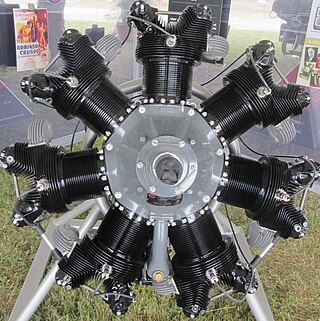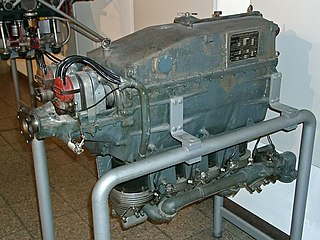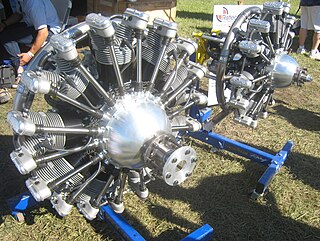 | |
| A Menasco-Salmson B-2, running on a test stand. | |
| Type | |
| Developed from | Salmson Z9 |
The B-2 was a conversion of Salmson Z9 water-cooled aircraft engines to air cooling by Albert Menasco in the United States.
 | |
| A Menasco-Salmson B-2, running on a test stand. | |
| Type | |
| Developed from | Salmson Z9 |
The B-2 was a conversion of Salmson Z9 water-cooled aircraft engines to air cooling by Albert Menasco in the United States.
Data from Jane's all the World's Aircraft 1928 [1]
Related lists

The Lycoming XR-7755 was the largest piston aircraft engine ever built in the United States, with 36 cylinders totaling about 7,750 in3 (127 L) of displacement and a power output of 5,000 horsepower (3,700 kilowatts). It was originally intended to be used in the "European bomber" that eventually emerged as the Convair B-36. Only two examples were built before the project was terminated in 1946.

The Argus As 10 was a German-designed and built, air-cooled 90° cylinder bank-angle inverted V8 "low power" aircraft engine, used mainly in training aircraft such as the Arado Ar 66 and Focke-Wulf Fw 56 Stösser and other small short-range reconnaissance and communications aircraft like the Fieseler Fi 156 Storch during, and shortly after World War II. It was first built in 1928.

The Warner Scarab is an American seven-cylinder radial aircraft engine, that was manufactured by the Warner Aircraft Corporation of Detroit, Michigan in 1928 through to the early 1940s. In military service the engine was designated R-420.

The Continental R-670 was a seven-cylinder four-stroke radial aircraft engine produced by Continental displacing 668 cubic inches and a dry weight of 465 lb (211 kg). Horsepower varied from 210 to 240 at 2,200 rpm. The engine was the successor to Continental's first radial engine, the 170 hp Continental A-70. This engine was used on many aircraft in the 1930s and 1940s. The R-670 was widely used in the PT-17 Stearman primary training aircraft of the U.S. military.

The Alvis Leonides Major is a British air-cooled 14-cylinder radial aero engine developed by Alvis from the earlier nine-cylinder Leonides.

The Siemens-Halske Sh 14 was a seven-cylinder air-cooled radial engine for aircraft produced in Germany in the 1920s and 1930s. First run in 1928, it was rated at 93 kW (125 hp). It was briefly distributed in the United States by Ryan Aeronautical as the Yankee 7.

The Argus As 8 was a four-cylinder, air-cooled, inverted inline aircraft engine produced in Germany by Argus Motoren in the 1930s.

The Alfa Romeo 115 is an Italian six-cylinder air-cooled inverted inline engine for aircraft use, mainly for training and light planes, based on the de Havilland Gipsy Six engine. Production totalled approximately 1,600 units. Derivatives of the 115 include the -1, bis, ter and Alfa Romeo 116.

The Alfa Romeo 110 was an Italian four cylinder air-cooled inverted inline engine for aircraft use, mainly for trainers and light aircraft. The Alfa Romeo 110 was based on the de Havilland Gipsy Major, with approximately 500 units produced. Derivatives of the 110 include the -1, ter and Alfa Romeo 111.

The Kinner K-5 was a popular engine for light general and sport aircraft developed by Winfield B. 'Bert' Kinner. With the boom in civilian aviation after Charles Lindbergh's transatlantic flight the K-5 sold well. The K-5 was a rough running but reliable engine and the K-5 and its derivatives were produced in the thousands, powering many World War II trainer aircraft. The K-5 was followed by the B-5, R-5 and R-55. Military engines were designated R-370

Szekely aircraft engines were three-cylinder radial engines built in Holland, Michigan in the 1920s and 30s. They were used to power small aircraft such as the Rearwin Junior, Taylor H-2 and American Eagle Eaglet. Often criticized for reliability issues and design flaws, many were replaced with better engines in their original airframes. Few examples still exist but a museum quality example is on display in the Holland Museum in Holland, Michigan.

The Armstrong Siddeley Cougar was an aero engine developed by Armstrong Siddeley in 1945. The design was a departure from earlier Armstrong Siddeley engines in many ways, it was the company's only nine-cylinder radial design. Although the engine was tested it did not find an aircraft application and was not produced.

The Rotec R3600 is a nine-cylinder radial engine built by Rotec Aerosport Pty Ltd in Australia. Initially released in 2005, it was a followup of the 7-cylinder Rotec R2800 released five years earlier. Both this engine and its smaller cousin have been frequently used as both replacement engines for vintage World War 1 aircraft, and reproduction aircraft from the same vintage. Some notable aircraft this engine has been used in are the Fokker Triplane, Sopwith Camel and the Nieuport 17.

The Salmson AD.3 or Salmson 3 Ad was a French designed, three-cylinder, air-cooled radial aero engine. It was also produced by British Salmson in Great Britain during the 1920s.

The Walter Regulus was a Czechoslovakian five-cylinder, air-cooled radial engine for powering light aircraft that first ran in 1934. The engine produced 186 kW.
One of Avia's own designs, the 1930s Avia Rk.12 was a seven-cylinder radial engine with a rated output of 150 kW (200 hp), built in Czechoslovakia.
The Timm Aircoach, also called the Timm Coach and the Golden Shell Special, was a custom-built, high-capacity, high altitude aircraft for charter flights.
The Clerget 16X was an experimental French 16-cylinder X engine built in about 1918.
The Renard Type 100 was a five-cylinder, radial piston engine, designed and produced in the late 1920s and early 1930s by Société Anonyme des Avions et Moteurs Renard (Renard) in Belgium.
The Pobjoy P was a British seven-cylinder, air-cooled, aircraft engine designed by Douglas Rudolf Pobjoy and built by Pobjoy Airmotors. It became the progenitor of the Pobjoy R/Niagara/Cataract family of small radial engines. A notable feature of the Pobjoy P was the propeller reduction gear which allowed the small engine to operate at more desirable higher speeds.